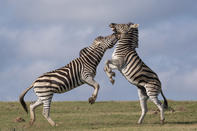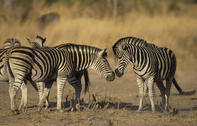Fit Stallions

Zebra do not have territories. Instead, the defended resource of a stallion is his four to six mares and their foals. A stallion practises a true harem system (one male with a number of females) which is bought at an incredible price. Colts leave the natal herd of their own accord at two years of age but between four and a half and twelve years of age, they will approach other herds with the intention of abducting fillies, one by one, to form their own harems.
This is no easy feat as each existing harem is defended valiantly by the stallion that will not let the young bachelor merely lure his fillies away but through a protracted period of sometimes a year, he is forced to prove himself. Often this is done through vicious fighting between the contender and the filly’s father as well as other suitors.
If the young stallion can get it right to mount and impregnate a filly during her five day per annum oestrus period, the filly will become his and she will remain faithful to him. He will then pursue another. This protracted courtship ensures that only the fittest stallions prevail.
Males practise flehmen to check the reproductive status of the mares. This is the process whereby liquid or air-borne chemicals from the mare’s urine are pumped into an organ on the roof of the mouth known as the Organ-of-Jacobsen (or vomeronasal organ). A facial grimace whereby the upper lip is pulled back, relaxes the opening of the glands allowing the chemicals to enter. The hormonal content of the urine is thus evaluated and the stallion consequently determines whether a mare is ready to mate or not.
Hierarchical Mares

Amongst the mares, there is a strict rank hierarchy which is linked to age but initially also to the ‘first wife, second wife’ arrangement. Whichever filly was abducted first becomes the dominant mare. The groups bond through allo-grooming (mutual grooming). The stallion is the harem’s defender. Equipped with an exceptionally powerful kick and the tenacity to inflict nasty bites, the stallion will run behind his harem when threatened.
The mares and foals bunch together and flee as a unit to ensure that they enjoy the protection of the stallion’s rear-guard. The contrasting black and white stripes are thought to facilitate the cohesion of the group at times of trouble. Black and white are the most visible colours to the zebra (who don’t have colour-vision), particularly in the low light conditions in which they are usually attacked.
When alarmed, zebra make a high-pitched and repeated "kwa-ha-ha" sound, an iconic call of the African bushveld. The foal of a zebra is remarkably prococial, standing on its own after just ten minutes of its birth. It can walk within half an hour and runs within the hour. The protracted year-long gestation ensures the foal is born well developed since it must be able to run to escape danger almost immediately in order to survive.
By Megan Emmett